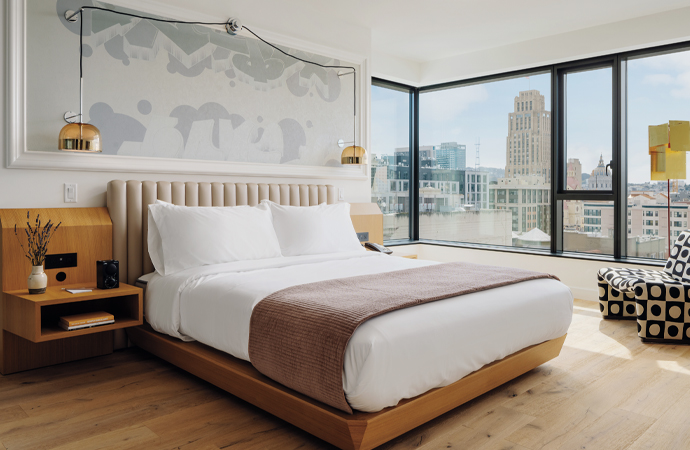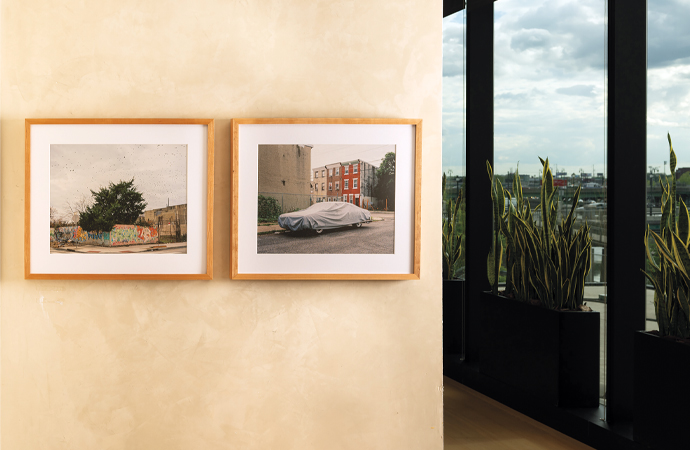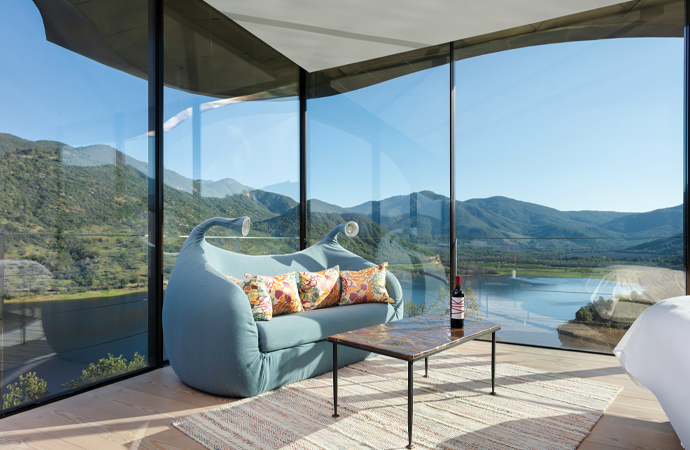The desire to collect is a natural human instinct, based on the tendency to gather objects for their beauty, rarity or history. However, the reasons people collect are as varied as the collections they compile. Hotels adopt this practice, as well, using unique assemblages to establish brand identity and connect with guests through items that are personal, purposeful or humorous.
San Francisco, On the Record
The recently launched Line San Francisco, located in the Mid-Market neighborhood, proves the old adage that one man’s trash is another’s treasure, starting with a collection of debris fashioned into a large-format wall installation by Thai multimedia artist Sasinun Kladpetch. During construction, she visited the hotel site, previously a parking lot, to collect found objects from the demolition. Kladpetch fused the foraged rubble with moss, lichen and twigs from nearby Presidio Park with resin and concrete to create more than 300 pieces, meticulously arranged and rearranged, which now hang along a wall that guides guests to the lobby.
Throughout The Line hotels in Austin, Los Angeles, Washington, D.C., and now the Bay Area, the pulse of the urban environment dictates the design narrative. At The Line San Francisco, that plays out in the graffiti-tagged headboards, amber-hued suspended lighting and details such as exposed concrete and bespoke ceramic pieces.


The Line hotel, San Francisco / Photo: Courtesy of Chase Daniel
“When concepting a hotel, one of the first things we ask ourselves is how we can positively integrate the community as we grow and develop,” says Stefan Merriweather, head of creative for The Line Hotels, which is part of Soho House & Co. “In San Francisco, we have a special opportunity to use our space to shine a light on the great creativity that exists here. Building an imposing structure in a neighborhood is a huge responsibility, and we strive to be sensitive to our impact while contributing to betterment.” Merriweather stresses that the brand’s creative direction and strategy touches everything from the physical environment to digital experiences to head space.
“When we think about how much time an individual actually spends with us, it’s a small percentage,” he says. “The majority of the time we’re really trying to maintain this long-distance relationship with them. The best thing that we can do is make sure that we’re top of mind when that person is ready to make a travel decision.”
The Line accomplishes that by making a lasting impression with cultural and community touchpoints. For instance, in San Francisco they partnered with 826 Valencia, a nonprofit dedicated to supporting under-resourced students with their writing skills.
“Kids wrote poems about their neighborhood, the Tenderloin,” Merriweather says. “What was really interesting was to see their positive outlook on their community. We put the poems in hotel rooms as a surprise for guests.”
They also collaborated with Hospitality House, which provides studio space for homeless artists. One artist’s work was commissioned for The Line SF and appears in every guest room. And for those who are lucky enough to have access to the hotel’s top suites, they will discover a record collection of which Merriweather is very proud.
“It first started in Austin, in our penthouse suite. We had a record player that was an old German console. We started a vinyl collection there,” he says. “In San Francisco, in our penthouse suite, we actually tapped Wrensilva from San Diego, which makes these incredible hi-fi record consoles. For the record collection, I really wanted to pull together albums that were connected to the Bay Area in some way. Because when you do that, you discover so much and you’re able to tell a story for the guests. One of my favorite records is from Vince Guaraldi, a very famous American jazz pianist from San Francisco. He is the man behind the music of Peanuts and we have his Charlie Brown record, which is incredible. It’s just amazing to put on when the party’s over.”
Other highlights of the collection, which currently includes about 50 records: Sly and the Family Stone, J Dilla and Peanut Butter Wolf. Merriweather is looking to engage Bay Area musicians to further build out the collection (similar to what The Line Austin did previously with The Black Angels).
Philadelphia’s Brightest Brush Stroke
Within Philadelphia’s Fitler Club, an inclusive social club and 14-room hotel, Tricia Maloney, director of visual arts, spearheads the club’s Artists in Residence Program, which has become one of the main attraction points for its expanding membership. Showcasing the talent of the city in a nontraditional gallery called Offsite, which doubles as Fitler’s coworking space, the club has attracted more than 2,000 members since its 2019 opening.


Saleem Ahmed’s Birds and Sneakers at Fitler Club, Philadelphia / Photo: Courtesy of Khalif Rivers
“The art component has brought so much and it is why many people join,” Maloney says. “It really informed the culture of the club.”
Fitler Club was cofounded by philanthropist and art collector Michael Forman with a focus on creating a diverse community and an affordable experience. Forman lent his personal art collection to the spaces, including high-concept works by Damien Hirst, photographs by Gordon Parks, and street-inspired graffiti from local muralists. The club also features loaned works from New York City’s Pace Gallery.
Forman decided to take the club’s commitment to art one step further and created the Artists in Residence Program to support Philadelphia’s vibrant cultural ecosystem. AIR displays artists’ work for two years; the art is promoted and hopefully sold to members. In exchange for the loan, artists receive a small stipend, a free membership and a marketing push that celebrates the work, creates programs and collector events and produces a commemorative book.
Early in 2023, Fitler Club’s third Artists in Residence initiative installed 16 participants, vetted from 166 applicants by a member advisory council and a jury of art experts. Many of the artists are people of color and women. They range from 20-year-old Malayah Reynolds—whose drawings in pencil and charcoal capture subjects in such hyperrealistic detail that they look like photographs, down to the braids in the hair—to the abstract expressionism of 77-year-old painter Larry Spaid. Colombian-born, Philadelphia-based lens media artist Idalia Vasquez-Achury has the largest work in the exhibit, featuring four photographs that address “liminal spaces between cultures and nationalities, and between physical locations and imagined or represented spaces, where immigrant women have built a sense of place, home and identity.”
For the first time, AIR is also exhibiting an anonymous collective of Black female artists known as Mz. Icar. Members include an illustrator, photographer, designer, prop stylist, street artist and collage artist, all celebrating the themes of women, global Blackness and play in their murals, photographs, illustrations, moving images and installations. Some paintings even use AI to literally speak to their audience with the download of a QR code, while an impressive corner installation drips in bursts of yarn art.
“We are a nontraditional gallery, showing multiple artists,” Maloney says. “You can come here, meet the artists, and learn about them. If you’re interested in acquiring art, you can talk directly to them about it. We don’t take any commission.”
A Compendium of Furniture in Cachapoal Valley
Carrie and Alex Vik created one of the most unique resorts in the world in 2014 with their Vik Hotel and Winery, located in Millahue in Chile’s Cachapoal Valley, two and a half hours from Santiago. This retreat with its floating structural roof of titanium and bronze sits atop a hill with panoramic views of Vik’s natural reserve.


Vik Hotel and Winery / Photo: Courtesy of Juan Pablo Jaramillo Gamboa
Every room feels as if it is a transparent vessel—much like a glass of wine—from which to view the splendor of nature. The living room, with paintings by Roberto Matta and a diptych from Anselm Kiefer’s series The Secret Life of Plants, is anchored by a central patio with a Zen garden surrounded by flora.
This is a place where art lives beyond the walls. With only 17 suites and five themed master suites, Carrie filled the modern building designed by Uruguayan architect Marcelo Daglio with a furniture collection boasting hundreds of ornate pieces. There is also a series of seven glass houses, known as Puro Vik, which immerse guests in nature. “
Vik comes from our love of art, design and architecture—a three-dimensional gallery,” she says. “Every piece was chosen by me and my husband, Alex, because it spoke to us, it was in no way ordinary, and it helped to communicate the message that we wanted our guests to receive. Our goal is to make our guest experience unique. I want them to move through the rooms and be drawn to everything they see, touch and taste: furniture, art, fabrics, lamps and light fixtures, wine bottles, wine, food, nature and more.” Building a collection like this in such an obscure place was a painstaking and laborious process, which unfolded over two years while Vik was built and furnished.
Furniture, art, fabrics and materials were sourced from all over the world, from auction houses, art dealers, furniture makers and artisans. “In addition, we create our own furniture and art,” Carrie says. “We collaborated with over 50 artists for Vik Chile. We have special pieces made in various places all over the world. For example, the light fixtures in the Milla Milla restaurant are made in Limoges from fine ceramics.”
In Puro Vik’s Antiquity house, find a gogotte sandstone formation from Fontainebleau, France, dating back 30 million years. The Hiroshige house features a series by Utagawa Hiroshige, born in 1797, considered one of the great masters of Japanese ukiyo-e art. There are many more examples of rare and precious pieces throughout.
And for those who love fashion, the H suite is paradise. Inspired by Hermès’ iconic orange suitcases and its roots as a maker of bespoke equestrian accessories, this corner accommodation with stunning floor-to-ceiling windows features a bathroom with inspirational photos from Vogue. From debris to poetry, vinyl to yarn art, furniture to ceramics, hotels’ collections undoubtedly work their way into guests’ consciousness.
“We have to be much more than a hotel bed,” Merriweather says. “We need to connect with people in many different ways, and when you do that, you build a deeper relationship with an individual. We see it as an opportunity to build a memory. When people have these sorts of experiences, they want to share them, they want to own them.”

